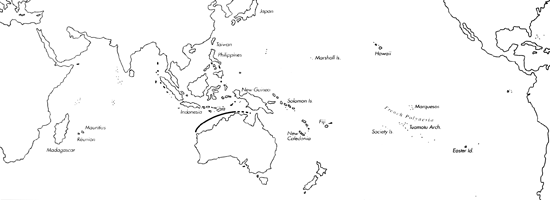Range: W. Australia; C. v. victoriae: Northern Territory to N. W. Cape; C. v. nodulosus: Shark Bay to Fremantle.
Description: Medium-sized to moderately large, moderately solid to solid; in C. v. victoriae, relative weight of similarly sized shells may vary by 50%. Last whorl ventricosely conical, also ovate or conoid-cylindrical in C. v. victoriae; outline convex, often less so to nearly straight below adapical third; left side concave to nearly straight at basal third. Shoulder angulate to sometimes subangulate. Spire of low to moderate height, outline usually concave to straight. Larval shell of 1.75-2 whorls, maximum diameter 1-1.1 mm. First 3.5-6.5 postnuclear whorls tuberculate. Teleoconch sutural ramps flat to slightly concave, with 1 increasing to 6-12 variably fine, weak to obsolete spiral grooves. Last whorl with variably spaced, distinct to obsolete spiral ribs basally; spiral sculpture generally less prominent in C. v. nodulosus.
| Shell Morphometry | ||
|---|---|---|
| L | - | |
| (C. v. victoriae 37 - 94 mm, usually to 65 mm; C. v. nodulosus 37 - 51 mm) | ||
| RW | 0.13-0.42 g/mm | |
| (L 37-63 mm) | ||
| RD | - | |
| (-C. v. victoriae 0.55 - 0.67;-C. v. nodulosus 0.59 - 0.65) | ||
| PMD | - | |
| (-C. v. victoriae 0.68 - 0.83;-C. v. nodulosus 0.75 - 0.80) | ||
| RSH | - | |
| (-C. v. victoriae 0.09 - 0.22;-C. v. nodulosus 0.14 - 0.22) | ||
C. v. victoriae (Pl. 65, Figs. 10-14): Ground colour white, often suffused with light blue and/or overlaid with yellowish or orangish brown. Colour pattern extremely variable: Last whorl in typical form with a network of fine light to blackish brown lines edging very small to medium-sized tents. Yellowish or orangish to blackish brown blotches arranged in 2-3 or more interrupted to continuous spiral bands and interspersed with coarse darker axial lines. Shells with typical pattern intergrade with shells with an axial pattern of bands and streaks to closely spaced fine wavy axial lines; pattern varies from completely white shells to shells heavily patterned on a brown or blue ground. Larval whorls and often also earliest postnuclear sutural ramps immaculate white. Following sutural ramps matching last whorl in colour pattern. Aperture white to pink, pinkish violet, bluish violet or blue. C. v. nodulosus (Pl. 65, Figs. 15-17): Ground colour white, sometimes suffused with pink and rarely shaded with blue. Colour pattern rather uniform: Last whorl with a network of fine yellow to brown lines forming very small to medium-sized tents. Yellow to yellowish brown, rarely dark brown flecks, spots, and spiral dashes arranged in 2-3 or more spiral rows and interspersed with coarse brown axial dots or dashes. Larval shell white. Teleoconch spire matching last whorl in colour pattern. Aperture bright pink, occasionally white. Periostracum matching that of C. v. victoriae.
Periostracum yellow-grey, thin, translucent, smooth.
Radular teeth with a laterally inflated adapical barb opposite a larger second barb; serration long; basal spur absent (Nybakken, 1990).
Habitat and Habits: Intertidal to about 10 m; C. v. victoriae on mud and sand bottoms of coral reef, beneath and among rocks and in rock pools, exposed or buried in sand (Whitehead, 1967; Singleton, 1978); C. v. nodulosus on intertidal and shallow-subtidal reef flats, often beneath rocks. C. v. victoriae is known to feed on worms within its natural habitat (Singleton, 1978), although its radular teeth morphology suggests molluscivory (see Nybakken, 1990).
Discussion: C. victoriae may be similar to C. textile, C. canonicus, and typical C. telatus. C. canonicus has a multispiral (2.75 whorls), narrower (0.8-0.9 mm), and pale pink larval shell; its last whorl is generally straighter in outline and often of conoid-cylindrical shape, while conoid-cylindrical last whorls are rarely seen in C. v. victoriae and absent in C. v. nodulosus. For comparison with C. telatus and C. textile, see the Discussions of those species. With regard to the disjunct neighbouring ranges, the conchological differences between C. victoriae and C. nodulosus do not justify separation at the species level. Shells with intermediate colour patterns are known from both the southern and the northern part of the species range (Korn, 1993). We therefore consider these taxa to represent geographic subspecies of the same species. C. complanatus (Pl. 65, Fig. 14) refers to an individual variant of C. v. victoriae with a rather broad last whorl, a finely reticulate pattern, and a rather low spire.

C. victoriae range map
This section contains verbatim reproductions of the accounts of 316 species of Conus from the Indo-Pacific region, from Manual of the Living Conidae, by Röckel, Korn and Kohn (1995). They are reproduced with the kind permission of the present publisher, Conchbooks.
All plates and figures referred to in the text are also in Röckel, Korn & Kohn, 1995. Manual of the Living Conidae Vol. 1: Indo-Pacific Region.
The range maps have been modified so that each species account has it own map, rather than one map that showed the ranges of several species in the original work. This was necessary because each species account is on a separate page on the website and not confined to the order of accounts in the book.